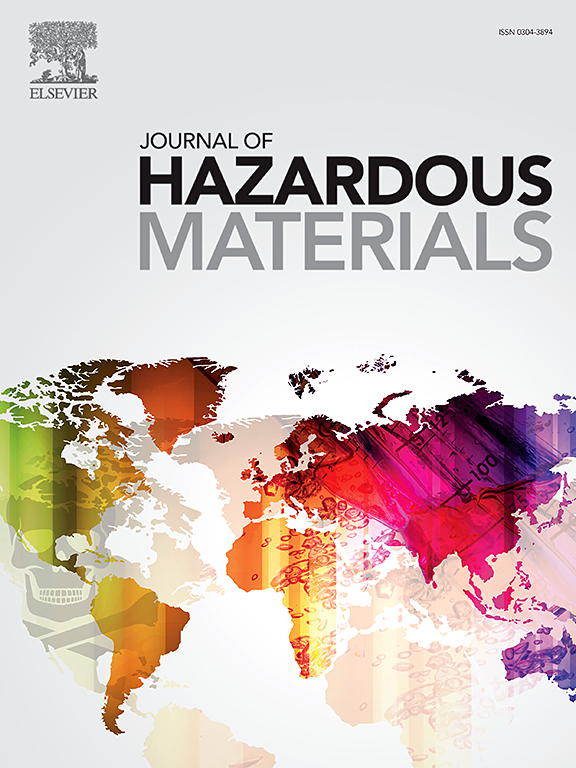Shapley加性解释揭示了气候、地形、人为活动和地球化学性质对土壤钴、镍和钒含量的影响
IF 11.3
1区 环境科学与生态学
Q1 ENGINEERING, ENVIRONMENTAL
引用次数: 0
摘要
土壤重金属环境驱动因素的量化对污染控制至关重要,但其相对重要性和临界阈值在宏观尺度上仍未量化。因此,基于随机森林模型的Shapley加性解释被用于分析沿4000 km样带土壤钴、镍和钒分布的环境驱动因素。结果表明,气候是主要影响因子,其次是地形、人为活动和土壤地球化学性质。具体而言,年平均降水量通过风化淋溶平衡(阈值约为670 mm)主导了这些金属的总含量和残留含量的分布,同时与年平均气温(超过5°C)协同作用,促进钒从不稳定状态转变为残留状态。海拔高度通过热液和有机质调节促进了有机结合镍和钒的富集。较低的人口密度阈值(97人km-2)和电力消耗阈值(555017千瓦时km-2)表明,最小的人为活动可以通过水泥衍生的碳酸盐循环提高碳酸盐结合金属。重金属的纬向衰减趋势主要是环境因子的双相效应及其相互补偿所致。因此,气候主导但与其他环境驱动因素协同共同塑造土壤钴、镍和钒的分布模式。本文章由计算机程序翻译,如有差异,请以英文原文为准。

Shapley additive explanations revealed the effects of climate, topography, anthropogenic activities and geochemical properties on soil cobalt, nickel and vanadium contents
The quantification of environmental drivers for soil heavy metals is crucial for pollution control, yet their relative importance and critical thresholds remain unquantified at the macroscale. Therefore, Shapley additive explanations based on a random forest model were used to analyze environmental drivers of soil cobalt, nickel and vanadium distributions along a 4000-km transect. These results revealed that climate was the dominant factor, followed by topography, anthropogenic activities, and soil geochemical properties. Specifically, mean annual precipitation predominantly shaped the distributions of total and residual contents of these metals through weathering-leaching equilibrium (threshold approximately 670 mm), while acting synergistically with mean annual temperature (exceeding 5 °C) to promote vanadium transformation from labile to residual states. Altitude enhanced organic bound nickel and vanadium accumulation via hydrothermal and organic matter regulation. Low thresholds for population density (97 people km-2) and electricity consumption (555017 kWh km-2) indicated minimal anthropogenic activities could elevate carbonate bound metals through cement-derived carbonate cycling. The attenuated latitudinal trends of heavy metals were primarily attributed to biphasic effects of environmental factors and their interactive compensation. Therefore, climate dominated but synergized with other environmental drivers to collectively shape soil cobalt, nickel and vanadium distribution patterns.
求助全文
通过发布文献求助,成功后即可免费获取论文全文。
去求助
来源期刊

Journal of Hazardous Materials
工程技术-工程:环境
CiteScore
25.40
自引率
5.90%
发文量
3059
审稿时长
58 days
期刊介绍:
The Journal of Hazardous Materials serves as a global platform for promoting cutting-edge research in the field of Environmental Science and Engineering. Our publication features a wide range of articles, including full-length research papers, review articles, and perspectives, with the aim of enhancing our understanding of the dangers and risks associated with various materials concerning public health and the environment. It is important to note that the term "environmental contaminants" refers specifically to substances that pose hazardous effects through contamination, while excluding those that do not have such impacts on the environment or human health. Moreover, we emphasize the distinction between wastes and hazardous materials in order to provide further clarity on the scope of the journal. We have a keen interest in exploring specific compounds and microbial agents that have adverse effects on the environment.
 求助内容:
求助内容: 应助结果提醒方式:
应助结果提醒方式:


